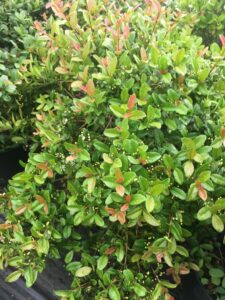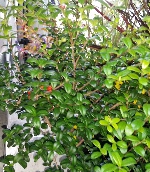Growing Simpson Stopper / Myrcianthes fragrans in the Northeast Florida
Jacksonville | St. Augustine Area Landscapes

Origins of Simpson Stopper / Myrcianthes fragrans :
– Native to Florida , The West Indies, Mexico and central America. A Florida Native shrub selection that is a member of the Eucalyptus family and makes an attractive shrub or small tree that bears flowers and fruits that help sustain local wildlife populations. The fleshy portion of the fruits is edible and slightly sweet although the seed portion is not and is bitter. The foliage when crushed has a nutmeg like scent.
An Easy care garden shrub and has long been a favored garden plant for attracting butterfly, hummingbird and other pollinators to the garden for the Northeast Florida Landscape.
Preferred Exposure for Simpson Stopper / Myrcianthes fragrans:
– Simpson stopper likes to be planted into full sun or shaded garden areas although they will tolerate a fair amount of shade, the foliage tends to be a bit thinner in heavily shaded locations here in the Northeast Florida, Jacksonville | St. Augustine area landscape.
Foliage of the Simpson Stopper / Myrcianthes fragrans:

– Evergreen foliage is a Glossy medium green with brightly reddish tinged new growth. Hardy in zones 9B-11
Soil Preference and Salt tolerance of Simpson Stopper/ Myrcianthes fragrans:
– Simpson Stopper is not particular about soil components and prefers well drained to occasionally wet soils. Drought tolerant once established into the landscape.
– Simpson Stopper shrubs have a moderate salt tolerance and can be utilized for coastal
plantings.
Size Variance of Simpson Stopper / Myrcianthes fragrans:
– Simpson Stopper can reach sizes of 20-30+ feet High | 15-20 feet spread and are often kept at height much lower in the landscape as they are easily managed at desired height and width with annual pruning. I chose this plant for a narrow shaded walkway in my mothers garden 15 plus years ago and it is maintained easily at the 7 ft height she desired with just the once a year or once every other year pruning, my favorite part is that the plants are so strongly upright they are only 2 or 3 ft wide! They don’t steal to much garden space but still provide her some privacy to her patio area.
Space plants at a minimum of 3-4 ft from the center of one plant to the center of another for foundation plantings or hedge screens. When allowing them to grow untrimmed for a small patio tree specimen spacing should be 8-10 ft from house foundation patio etc.
Growth Habit of Simpson Stopper / Myrcianthes fragrans:
- upright habit
Growth Rate of the Simpson Stopper / Myrcianthes fragrans:
– Slow to moderate growing shrub that establishes itself slowly into the landscape. Expect 3-6 inches of growth annually in a shaded location and 6-12 inches a well watered sunnier location.
Blooms of the Simpson Stopper / Mrcianthes fragrans:
– Blooms periodically throughout the year and are followed by berries that mature bright red. Blooms attract Butterflies and other local pollinators and fruit feeds the birds and other local wildlife! The berries are touted to be a favorite of the Florida State bird the Mockingbird.
Water Requirements of Simpson Stopper / Myrcianthes fragrans:
– Dwarf Bottlebrush are fairly low water and drought tolerant once they are established into the landscape. Remember to check their water needs daily after planting to get them rooted and established into the landscape quickly before allowing them to grow on their own in non irrigated spaces. Click the link below for how to properly water your newly planted Dwarf Bottlebrush shrubs.
– Watering your newly planted smaller shrubs and flowers
Butterfly or Bird Attracting:
– Attracts butterflies hummingbirds and other pollinators to the garden. Blooms provide and excellent nectar source and fruits feed the birds!
Best Uses For Simpson Stopper / Myrcianthes fragrans in the Northeast Florida Landscape:
- Great Native plant selection for use on home foundation plantings. Use as the tallest layer of your home foundation plantings.
- Great for use as a smaller specimen evergreen patio tree
- Great for use as a privacy screen or edge of property border planting as it tolerates many soil and sun situations allowing for use in different areas of the landscape
- hardy shrub selection with little pest or disease problems, low water needs, low maintenance and trimming requirements that make for an all round easy care plant with a little extra splash of color in late spring and early summer.
- Pollinator friendly plant selection – great for the butterflies and other local pollinators and wildlife
Care of S & J Nursery’s North Florida | Jacksonville | St. Augustine Dwarf Bottlebrush
Shrubs:
- Simpson Stopper should be pruned once a year or when they become untidy to shape. Plants respond wel to light or heavy pruning and flush new foliage quickly following trimmings.
- Simpson Stopper shrubs can be planted in the North Florida | Jacksonville | St. Augustine area at any time during the year. In normal and well draining soils dig the hole as deep as the root ball and two to three times as wide. Plant the top of the root ball level or slightly higher than the surrounding soils. Avoid planting in poorly drained soils.
- Check the plants water needs every day during the establishment period. For most 3 gallon size shrubs in the North Florida landscape in average soil, that is neither heavy clay that holds water or really sandy that will take 2-3 weeks of daily watering to ensure that your newly planted shrub will begin to put out new roots and grow into its new home happily. After the first few weeks begin tapering back your watering to every other day then every third day and so on until your newly planted items are flourishing without your assistance.
- Simpson Stopper may need supplemental irrigation during times of excessive heat or drought.
– IMPORTANT: If planting shrubs in heavy clay soils that hold allot of water after a rain or irrigating, remember to check the soil for moisture by sticking your fingers into the soil near the root ball of the newly planted shrub down to 2-3 inches. If it remains wet from the previous watering wait for the top 2-3 inches to dry out before watering again.
– IMPORTANT: When planting shrubs into poor sandy soils be sure to amend the planting hole by mixing compost or cow manure etc. with the native soil that will go back in the hole around the new plants root ball when installing your shrub material, this will not only give your new shrubs good soil to grow its new roots into but help it hold water.
- When planting shrubs from containers be sure to loosen the roots as much as possible pulling loose roots away from the root ball before installing your new plants, if the roots are to tight to easily loosen with your hands use a knife to cut a few slits into the root ball being careful to go all
the way from the top to the bottom and making the cut at least an inch deep. This will ensure that your plant will immediately begin to form new roots into its new surrounding soil.
Planting your new smaller shrubs and flowering plants
- Mulch newly planted shrubs whenever possible. Shrubs will benefit from a 3-4 inch layer of arborists wood chips, Pine bark or Pine Straw.
- Fertilize each spring with a shovelful of good garden compost or a mixture or slow release poly coated plant food like Osmocote or Staygreen. Be sure when fertilizing to sprinkle the fertilizer around the mulch circle underneath the foliage of the shrubs.

